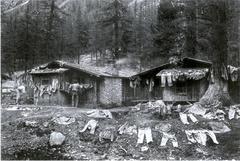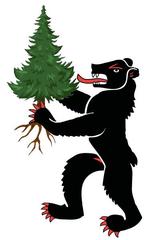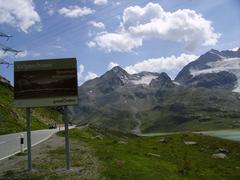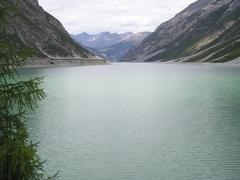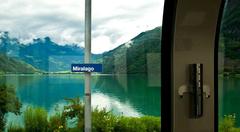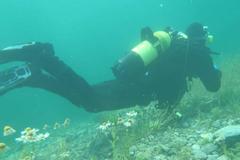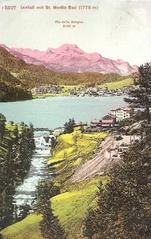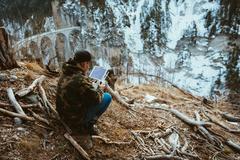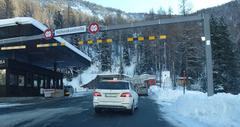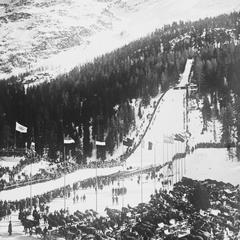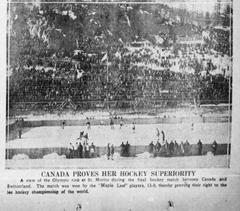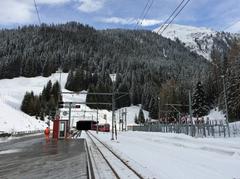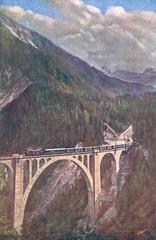Burg Belmont Visiting Hours, Tickets, and Historical Site Guide in Graubünden, Switzerland
Date: 04/07/2025
Introduction: Burg Belmont—A Window Into Alpine Medieval Heritage
Burg Belmont, perched atop a rocky outcrop in Switzerland’s largest and only trilingual canton, Graubünden (Grisons), is among the most evocative medieval castle ruins in the Alps. With origins dating back to the 12th–13th centuries, it was constructed by the Lords and Barons of Belmont—key figures in the region’s political and ecclesiastical evolution. As a strategic fortress, Burg Belmont controlled vital Alpine trade routes and stood witness to pivotal regional events, such as the 1352 “Belmonter Fehde.” Today, its ruins narrate a compelling story of medieval life, multicultural identity, and the enduring interplay between nature and history in Graubünden.
This guide provides comprehensive, up-to-date information for planning your visit, including historical context, visiting hours, ticketing, accessibility, guided tours, sustainability practices, and nearby attractions. For further details, consult authoritative sources such as the Grisons Tourism Office, the State Archives of the Grisons, and the official Burg Belmont website. Digital planning tools like the Audiala app offer interactive experiences and practical guidance.
Table of Contents
- Introduction
- Historical Overview
- Visiting Burg Belmont
- Sustainable Tourism and Conservation
- Nearby Attractions in Graubünden
- Practical Visitor Tips and FAQ
- Conclusion
- Sources
Historical Overview
The Lords and Barons of Belmont
The Freiherren von Belmont, first documented in 1139, were influential nobles who shaped the Anterior Rhine Valley’s destiny. Their name, meaning “beautiful mountain” in Latin and Romansh, reflects both the region’s diverse linguistic heritage and its dramatic topography. Notable family members contributed to religious and educational life—such as Konrad III, Bishop of Chur, and Heinrich von Belmont, a medieval scholar. Although the family line ended in 1371, their legacy resonates through the castle’s ruins.
Medieval Architecture and Archaeology
Burg Belmont exemplifies medieval hilltop castle design:
- Main Tower (Keep): The robust, rectangular granite tower, with defensive arrow slits and residential quarters, remains partially intact.
- Curtain Walls and Gatehouse: Outlines and remnants reveal the fortress’s perimeter and access points, including traces of a drawbridge.
- Service Buildings and Cistern: Foundations of kitchens, storerooms, and a stone-lined cistern illustrate the castle’s resilience during sieges.
Interpretive signage on-site provides diagrams and historical context to help visitors visualize the original structure and its daily life.
Regional Power and Multicultural Identity
Graubünden’s trilingual character (German, Romansh, Italian) is woven into Burg Belmont’s history. The castle’s strategic location allowed it to oversee trade routes and maintain communication with neighboring fortifications like Crap Sogn Parcazi and Ortenstein. The 1352 “Belmonter Fehde” feud, involving the Werdenberg family, is a notable episode in its turbulent past. Even after its decline in the late 14th century, Burg Belmont remained a symbol of regional identity and legal authority.
Preservation efforts dating back to the 1930s have safeguarded the ruins, ensuring their continued role in Graubünden’s cultural landscape.
Visiting Burg Belmont
Visiting Hours and Tickets
- Opening Hours: Burg Belmont is an open-air site, generally accessible year-round during daylight hours. The best visiting window is from May to October, between 8:00/9:00 AM and 6:00 PM, when trails are clear of snow. For safety, always visit during daylight.
- Admission: Entry to the castle ruins is free of charge. Occasionally, guided tours or special events may require a fee and advance reservation—check with local tourism offices or the official Burg Belmont website for updates.
Accessibility and Safety
- The approach to Burg Belmont involves moderate hiking (30–45 minutes from Sumvitg) over uneven, sometimes steep, terrain. Sturdy hiking boots are essential.
- The trail is not suitable for wheelchairs or strollers; partial wheelchair access is possible only to the visitor information point.
- Families with older children and reasonably fit visitors will find the hike manageable. Supervise children due to uneven ground and exposed heights.
- There are no commercial facilities (cafés, shops, restrooms) at the site. Bring water, snacks, and sun protection.
Getting There: Transport and Hiking Routes
- By Public Transport: Swiss Federal Railways (SBB) connects to Disentis/Mustér, with regional buses to Sumvitg. From the village, follow marked trails to the castle (SBB Grisons).
- By Car: Drive to Sumvitg via the A13 motorway; parking is available in the village, with signage to the trailhead.
- Hiking: The trail ascends through forest and alpine meadows, with scenic viewpoints and benches along the way.
Guided Tours and Special Events
- While no regular guided tours are available, local tourism offices in Sumvitg and Disentis occasionally organize group walks, educational tours, and events during heritage festivals. Advance booking is recommended for special tours (Surselva tourism office).
- Multilingual interpretive panels (German, Romansh, English) offer self-guided historical insights.
Sustainable Tourism and Conservation
Environmental Sensitivity and Preservation
Burg Belmont is set within a pristine Alpine landscape that is both ecologically fragile and culturally significant. Visitor impacts—such as trail erosion, waste, and wildlife disturbance—are minimized through:
- Marked trails: To protect vegetation and archaeological remains.
- Visitor education: Signage and local campaigns promote responsible behavior.
- Public transport incentives: Reduce emissions and traffic congestion.
- Regular maintenance: Local authorities monitor and restore the site as needed.
Sustainable Tourism Initiatives
Grisons promotes green travel:
- Use of Rhaetian Railway and local buses.
- Eco-friendly accommodations and waste reduction campaigns.
- Community-based tourism supporting local crafts, cuisine, and traditions.
Climate Change and Long-Term Stewardship
Alpine regions face growing climate risks, including glacial retreat and extreme weather. Conservation programs focus on climate resilience, habitat restoration, and carbon footprint reduction for visitors.
Nearby Attractions in Graubünden
- Sumvitg Village: Noted for traditional architecture and the modern Church of St. Benedict by Peter Zumthor.
- Surselva Hiking Trails: Connect Burg Belmont with other historical and natural sites.
- Other Castles: Crap Sogn Parcazi, Ortenstein, and regional museums provide deeper insights into Graubünden’s medieval heritage.
- Natural Wonders: Rhine Gorge (Swiss Grand Canyon), Engadine Valley, and wellness spas like Bogn Engiadina Scuol.
Practical Visitor Tips and FAQ
Q: Are there entrance fees or tickets?
A: No, visiting Burg Belmont is free. Special tours may have a modest fee.
Q: What are the official visiting hours?
A: Open-air access year-round; recommended between 8:00/9:00 AM and 6:00 PM, May to October.
Q: Is the hiking trail suitable for children or elderly visitors?
A: The trail is moderately difficult and best for families with older children and those with reasonable fitness.
Q: Are guided tours available?
A: Occasionally, through local tourism offices; check in advance for schedules.
Q: What facilities are on-site?
A: Multilingual interpretive panels and picnic spots; no shops or restrooms.
Q: How do I get there by public transport?
A: SBB trains to Disentis/Mustér, regional buses to Sumvitg, then a marked trail to the castle.
Q: Is the site accessible for wheelchairs or strollers?
A: No; the trail is rugged and not wheelchair/stroller accessible.
Q: How can I support sustainable tourism?
A: Use public transport, stay on marked paths, minimize waste, and patronize local businesses.
Conclusion
Burg Belmont is a remarkable destination for anyone intrigued by medieval history, Alpine landscapes, and Switzerland’s multicultural heritage. Its freely accessible ruins, panoramic views, and interpretive resources offer a rich and educational experience. By following sustainable travel practices and supporting local initiatives, visitors help ensure that Burg Belmont remains a vibrant part of Graubünden’s living legacy for generations to come.
For maps, guided audio tours, and the latest event updates, download the Audiala app. Stay connected via social media and explore related articles on Swiss castles and hiking adventures.
Sources
- Burg Belmont Visiting Hours, Tickets, and Exploring Grisons Historical Sites, 2025, Grisons Tourism Office (https://www.gr.ch/EN/institutions/administration/ekud/afk/sag/Seiten/start.aspx)
- Visiting Burg Belmont: History, Access, and Tips for Exploring Grisons’ Historic Castle Ruins, 2025, SBB Grisons (https://www.sbb.ch/en/leisure-holidays/excursions-switzerland/regions/grisons.html)
- Burg Belmont Visiting Hours, Tickets, and Sustainable Tourism Tips in Grisons, Switzerland, 2025, Burg Belmont Official Website (https://www.burgbelmont.ch)
- Grisons Tourism Office, 2025 (https://www.grisons.ch/en)
- Swiss Federal Railways (SBB), 2025 (https://www.sbb.ch/en/leisure-holidays/excursions-switzerland/regions/grisons.html)
- Surselva tourism office
- Rhaetian Railway Information
